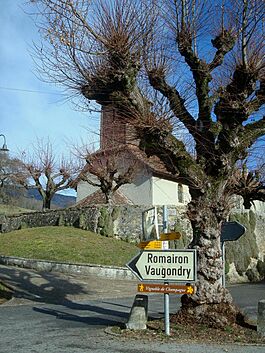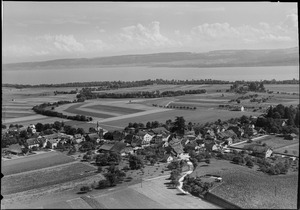Champagne, Switzerland facts for kids
Quick facts for kids
Champagne
|
||
|---|---|---|

Champagne village
|
||
|
||
| Country | Switzerland | |
| Canton | Vaud | |
| District | Jura-Nord Vaudois | |
| Area | ||
| • Total | 3.92 km2 (1.51 sq mi) | |
| Elevation | 449 m (1,473 ft) | |
| Population
(Dec 2020 )
|
||
| • Total | 1,062 | |
| • Density | 270.9/km2 (701.7/sq mi) | |
| Demonym(s) | Lè z'Aragne Les Champagnoux |
|
| Postal code |
1424
|
|
| Surrounded by | Romairon, Fontanezier, Bonvillars, Grandson, Fiez, Fontaines-sur-Grandson, Vaugondry | |
Champagne is a small town, also called a municipality, in Switzerland. It's located in the canton of Vaud, within the Jura-Nord Vaudois area.
Contents
History of Champagne
The town of Champagne was first mentioned way back in the year 885. Back then, it was known as Campania.
The Name Dispute
In 1998, Switzerland made an agreement with the European Union. As part of this deal, the people of Champagne had to stop using their town's name on products they made after 2004. This was because the name "Champagne" is also famous for a sparkling wine from France.
After a legal battle in 2002, the town was forced to remove the name from their local products in 2004. This change had a big impact on their wine sales. They used to sell about 110,000 bottles of wine each year, but after the name change, sales dropped to only 32,000 bottles. In April 2008, the villagers voted to keep trying to use their town's name on their products.
Geography of Champagne
Champagne covers an area of about 3.92 square kilometers (about 1.5 square miles).
Land Use
- About half of the land (51.5%) is used for agriculture, like farms.
- A large part (36.7%) is covered by forests.
- About 9.9% of the land has buildings or roads.
- A small amount (1.0%) is made up of rivers or lakes.
- Another 1.0% is land that can't be used for farming or building.
Most of the forested land is thick forest. For farming, a lot of the land is used for growing crops, and some is used for pastures or vineyards. All the water in the town comes from flowing rivers.
Location and Surroundings
Champagne used to be part of the Grandson District until 2006. Now, it's part of the newer Jura-Nord Vaudois district.
The town stretches from Lake Neuchatel up to the first hills of the Jura Mountains. It's also located right on the western border with France. The municipality includes the main village of Champagne and smaller areas called hamlets, such as Saint-Maurice, Les Pasquières, and Sous le Closel.
Champagne's Coat of Arms
A coat of arms is like a special symbol for a town or family. The coat of arms for Champagne is blue and features three golden mushrooms. They are arranged with two mushrooms at the top and one below them.
People of Champagne (Demographics)
Champagne has a population of about 700 people. As of 2008, about 12.5% of the people living there were foreign nationals. Over ten years, from 1999 to 2009, the population grew by almost 20%. This growth was mostly due to people moving into the town.
Languages Spoken
Most people in Champagne speak French, about 90.7% of the population. The second most common language is Portuguese, spoken by about 2.8% of residents. About 1.8% of people speak German, and a few also speak Italian.
Where People Come From
In 2000, about 28% of the people living in Champagne were born there. About 40% were born in the same canton (Vaud). Around 16% were born in other parts of Switzerland, and 15% were born outside of Switzerland.
Age Groups
Here's a look at the different age groups in Champagne as of 2009:
- Children (0-9 years old): 11.7%
- Teenagers (10-19 years old): 16.1%
- Young adults (20-29 years old): 10.8%
- Adults (30-59 years old): 44.7%
- Seniors (60 years and older): 16.4%
Households and Homes
In 2000, there were 261 private households in Champagne, with an average of 2.5 people living in each. About 30% of households had only one person. Many households were married couples, some with children and some without.
Most of the buildings in Champagne are single-family homes. Many of these homes were built a long time ago, before 1919. There are also some multi-family buildings.
The town had 280 apartments in 2000. Most of them had four rooms. About 91.8% of these apartments were lived in all the time. In 2009, new homes were being built at a good rate.
Population Over Time
The chart below shows how the population of Champagne has changed throughout history:

Interesting Sights
The entire village of Champagne is recognized as an important Swiss Heritage Site. This means it has special historical or cultural value.
Economy of Champagne
In 2010, the unemployment rate in Champagne was 4.3%. This means a small percentage of people looking for jobs couldn't find them.
Jobs and Businesses
As of 2008, there were different types of jobs in Champagne:
- Primary sector: 22 people worked in this sector, which includes things like farming. There were 8 businesses in this area.
- Secondary sector: 258 people worked in this sector, which includes manufacturing (making things) and construction. There were 9 businesses here.
- Tertiary sector: 36 people worked in this sector, which includes services like shops, restaurants, and offices. There were 16 businesses in this area.
Overall, 328 people living in Champagne had jobs, and about 40% of them were women. Many people who work in Champagne actually travel there from other towns. Also, about 10.5% of the workers coming into Champagne are from outside Switzerland. Most people (61.3%) use a private car to get to work, while 7.9% use public transportation.
Religion in Champagne
Based on a census from 2000, here's a look at the religious groups in Champagne:
- About 24.7% of the people were Roman Catholic.
- About 54.1% belonged to the Swiss Reformed Church.
- Smaller groups included Orthodox Christians and other Christian churches.
- About 2.45% of the population was Islamic.
- About 12.25% of the people said they didn't belong to any church, or were agnostic or atheist.
Education in Champagne
Education is important in Champagne. About 40.4% of the people have finished non-mandatory upper secondary education. This is like high school. Also, about 12.9% have gone on to higher education, like university or a specialized college.
School System
In the 2009/2010 school year, there were 122 students in the Champagne school district.
- Pre-school: In the Vaud canton, two years of non-required pre-school are offered.
- Primary school: Students attend primary school for four years. There were 62 students in the local primary school.
- Lower secondary school: This program lasts for six years. There were 59 students in these schools.
Some students (97) came to Champagne schools from other towns, while 94 students from Champagne went to schools outside the municipality.
See also
 In Spanish: Champagne (Vaud) para niños
In Spanish: Champagne (Vaud) para niños





